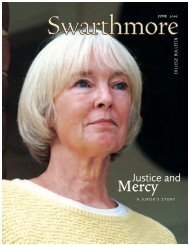ooks + artsThomas Preston ’55, Patient-Directed Dying: A Call for LegalizedAid in Dying for the Terminally Ill,iUniverse, New York, 200658 : swarthmore college bulletina PeacefulTom Preston leaves few dry eyesas he portrays the dying processof four terminally ill patients inhis newest book. Taking us intothe homes and thoughts of thesepatients and their families, Prestondescribes their suffering andtheir often thwarted attempts toexperience a peaceful death. HeSeekingdescribes them as caught up in“medical dying,” hooked up tomachines in futile attempts todeny death.Although about three-quartersof us report that we would like todie at home surrounded by lovedones, most of us die in the hospitalundergoing aggressive last-Deathditch efforts to keep us alive. Thisgap between how we, as a society,envision the humane death andthe reality of the modern deathexperience needs to be closed. As Preston notes, if more of us sawthe conditions under which our loved ones die, we might be moresupportive of instituting legal measures to help the terminally illachieve a peaceful death. But during medical emergencies, the laymanis usually escorted out of the hospital room. This book helps toeducate the public.One of the greatest contributions of Patient-Directed Dying is itschallenge of the more commonly used phrase “physician-assistedsuicide” to describe what exactly these terminally ill patients areseeking. As Preston argues, suicide carries terrible connotations inAmerican society. When we hear “suicide,” we envision the tragicdeath of someone who had a future. In the cases Preston describes,these patients have fought the good fight, but they are in every senseterminally ill. This is why he argues for our using the term “patientdirecteddying.” There is no question that these patients are dying.He is calling for society and the medical profession to help thesepatients choose how and when to die when all further attempts toextend life are useless. But why is palliative care not enough? Don’twe have morphine and other drugs that help relieve the suffering ofthe dying? Dying is often a difficult process. Even those heavilysedated sometimes suffer unbearable pain and extreme shortness ofbreath. More needs to be done.Preston also helps us to understand why doctors are reluctant tohelp their terminally ill patients die—even if this would require littlemore than writing a prescription for sleeping pills that patientswould take at a time of their choosing. Doctors are driven to savelives. The idea of aiding death is completely antithetical to theirmedical training and worldview. Preston also describes the unfortunateabandonment of some terminally ill patients by their physiciansonce it becomes clear that there is nothing more that can bedone or when patients refuse to undergo one more medical procedurethat is unlikely to help.Why does the doctor run away? The fracturing of the doctorpatientrelationship that has accompanied many structural changesin the delivery of medical care helps explain some of this behavior.Fewer close personal ties between doctors and patients facilitate thiskind of distancing. Some doctors also argue that their time is betterspent helping nonterminal patients. But it is also true that distancing,as death draws near, is a coping mechanism for physicians. AsPreston makes very clear, it is not easy to watch another humanbeing die. And for the physician, the death may be a very direct andpainful reminder of a failure to save this patient. We need to understandbetter how we can train physicians to both save lives and helpthe terminally ill die. This is an area that needs more attention fromthe profession of medicine and the public.We also need to understand better why patients seek the helpof doctors to die. Couldn’t these terminally ill patients tell theirdoctors that they are having trouble sleeping, without saying thatthey intend to end their lives, to get a prescription for sleeping pills?These patients are looking for more than just a way to end theirlives. They are looking for society and the medical profession torecognize and legitimize their decision to die. They are themselvesrecognizing their interconnectedness with the wider society, evenas they face the reality of soon leaving that society. We need tohear their cries for help and act now. Preston has heard and is tryingto help.—Virginia Adams O’ConnellVisiting Assistant Professor of SociologyJANUSZ KAPUSTA/©IMAGES.COM/CORBIS
Carolyn (Goldberg) Burke ’61, author,art critic, translator, and teacher, is currentlyon a book tour for her latestwork, Lee Miller: A Life, Alfred A.Knopf, 2005. This biography of theearly photojournalist was featured inThe New York Times daily and Sundayreview sections, picked as the editor’schoice, and nominated for the BiographyAward by the National Book CriticsCircle. In 2007, it will be published inFrench translation by Autrement. Burkeis also the author of the criticallyacclaimed book Becoming Modern: TheLife of Mina Loy. She has taught atPrinceton; the Universities of California–SantaCruz and Davies; the Universitiesof Western Sydney and NewSouth Wales, Australia; and at the Sorbonneand the University of Lille,France.BooksRoger Abrahams ’55, with Nick Spitzer, JohnSzwed, and Robert Thompson, Blues for NewOrleans: Mardi Gras and America’s Creole Soul,University of Pennsylvania Press, 2006. Theauthors present the return of Mardi Gras toNew Orleans as a symbol of the region’sreturn to vitality and its ability to expressand celebrate itself.Virginia (Stern) Brown ’49, In Transit: AMemoir, XLibris Corp., 2005. With wit andsensitivity, the author recounts her journeythrough the 20th century.Tom Graham and Rachel Graham Cody ’94,Getting Open: The Unknown Story of Bill Garrettand the Integration of College Basketball,Atria Books, 2006. More than “just a basketballbook,” this volume tells the story of amajor breakthrough in sports and civilrights.Daisy Fried ’89, My Brother Is Getting ArrestedAgain, University of Pittsburgh Press,2006. The poet’s second collection celebratesthe contradictions and quandaries ofcontemporary American life.Guiomar Borrás, Stephen Henighan ’84,James Hendrickson, and Antonio Velásquez,Intercambios, Nelson, 2006. This introductorySpanish language textbook is the first tobe designed especially for Canadian students,using examples specific to Canadaand Canadian society.Marc Elihu Hofstadter ’67, Shark’s Tooth,Regent Press, 2006. A collection of poems,divided into five thematic sections, providesa kaleidoscopic view of a gay man’s life.Jacob Howland ’80, Kierkegaard and Socrates:A Study in Philosophy and Faith, CambridgeUniversity Press, 2006. This book examinesthe relationship between philosophy andfaith in Søren Kierkegaard’s PhilosophicalFragments.Jane (Stallmann) Jaquette ’64 and GaleSummerfield (eds.), Women and Gender Equityin Development Theory and Practice, DukeUniversity Press, 2006. In this collection,contributors reflect on the connectionsbetween women’s well-being and globalization,environmental conservation, landrights, access to information technology,employment, and poverty alleviation.Madeleine Kahn ’77, Why Are We ReadingOvid’s Handbook on Rape?: Teaching andLearning at a Womens’ College, Paradigm Publishers,2005. Kahn raises feminist issues ina way that reminds people why they matter.Scott Kugle ’91 (trans.), The Book of Illumination(Kitab al-Tanwir fi Isqat al-Tadbir), FonsVitae, 2005. This translation of a classicwork of Islamic spirituality has been describedas “unique,” “lucid,” and “lyrical.”Christopher Lehmann-Haupt ’56, The MadCook of Pymatuning, Simon & Schuster,2005. This chilling novel about a boys’ summercamp in the 1950s is reminiscent of Lordof the Flies.Jenny Lombard ’85, Drita, My Homegirl, G.P.Putnam’s Sons, 2006. In this novel for middle-graders,the author tells an urban multiethnicstory of two girls from different cultureswho develop an unlikely friendship.Jennifer Ruth ’91, Novel Professions: InterestedDisinterest and the Making of the Professional inthe Victorian Novel, The Ohio State UniversityPress, 2006. This work offers the reader anew way to view the role of professions inestablishing definitions of value in Victorianliterature.Mary Ann (Tomkins) Segal ’62, GettingThrough the Wilderness: The Fuel Crisis, GlobalWarming, and the Hydrogen Frontier, Author-House, 2006. This book will enlighten andempower readers about the benefits of alternativeenergy.Mike Sharpe ’50, Thou Shalt Not Kill, UnlessOtherwise Instructed, North Castle Books,2005. In this collection of poems and stories,the author uses humor to illuminate thehorror and agony of the Iraq War.Requiem for New Orleans, North CastleBooks, 2006. In a further poetry collection,the poet laments the destruction of a greatcity, expresses scorn for those who allowedthe devastation, and meditates on man’sability to overcome loss.Katherine Stanton ’94, Cosmopolitan Fictions,Routledge, 2006. This work proposes“cosmopolitan fiction” as both a descriptiveterm for a literary genre that probes states offeeling, modes of belonging, and practices ofcitizenship in a pluralized cosmos and as aninterpretive lens that allows us to glean newinsights into works that thematize migration,exile, and diaspora.Richard Valelly ’75 (ed.), The Voting RightsAct: Securing the Ballot, CQ Press, 2005. Inthis collection of essays, scholars explore theorigin, development, and consequences ofthis landmark legislation.Brenda Webster ’58, The Beheading Game,Wings Press, 2006. In this novel, the authorcrosses the classic medieval poem “Gawainand the Green Knight” with a contemporarylove story between two men.TheaterLaurie (Daniels) Blazich ’63, Signs of Peace(and the Star in the East), Actor’s Theatre ofSacramento, 2005. This is the second play bylongtime social worker Blazich. Last year, theauthor received an Ellie Award for her firstdrama, Backwater Park.june 2006 : 59

















